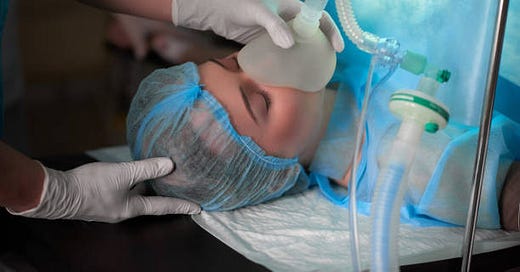Anesthesia Gases Cause Global Warming
For your next surgery - swig some tequila and bite a stick
Above: time to enter the magic realm.
Above: the brutal cost of gaseous anesthesia. Not.
Dear Readers, I am always looking for new and obscure subjects about “human-made global warming” that hopefully will elicit some interest, chuckles, and educate as well. To that end, I recently published the article:
In the comments section of the asthma inhaler article, FREEDOMLOVER shared that some doctors were also concerned about gaseous “waste” anesthesia from surgeries causing global warming, which piqued my interest.
I soon uncovered a voluminous academic literature on anesthetics causing “global warming”, and learned that only about 5 % of the gas is utilized by the patient for the nite-nite, and that 95 % is wasted or goes up the stack.
I also discovered an article from the prolific Thomas J Shepstone of Energy Security and Freedom that described how so called “climate experts” were telling the world that excess anesthesia gases from surgical procedures could overheat the planet.
Per Thomas, and in opposition to the fear mongers, a recent CO2 Coalition article concluded that there were negligible effects:
Based on our estimates, the continued emissions of nitrous oxide (both non-anesthetic and anesthetic), sevoflurane, isoflurane and desflurane would cause a combined temperature increase of about 0.032 °C in 50 years and of about 0.064 °C in 100 years. Such a rise in temperature is negligible and cannot be measured or felt.
Above data shows infinitesimal potential change in temperature due to anesthetic gases, from: Emissions of Anesthetic Gases Cause Negligible Warming.
The CO2 Coalition article should not be much of a surprise, as common sense would dictate that anesthetic gases probably represent only a tiny fraction of the total - a real “flea on the ass of an elephant” scenario, not unlike asthma inhalers causing global warming.
Indeed, it was estimated by one key cited reference that anesthesia gases maybe contribute 0.1 % to the total USA “greenhouse gas emissions”.
Above: estimated 0.1 % inhaled anesthetics contribution to total USA CO2 from Environmental and Occupational Considerations of Anesthesia: A Narrative Review and Update.
Anesthesia Industry Gets into the Act to Save the Planet (Follow the Money)
Dräger is a large company that manufactures and sells anesthesia delivery equipment worldwide. They also sell other safety equipment and Dräger rebreathers that our Tier 1 guys use when sneaking about underwater.
Above: the mighty Perseus® A500 anesthesia machine from Dräger.
Dräger wants their customers and patients to know that they are “global warming” conscious and have green cred (so it does not effect their bottom line) per brochure below:
Above: roughly 95 % of the gas goes up the stack. Turning down the flow rate to 1L/min over 6 hrs equals to only 1,134 miles driving a car. Feel better?
Conclusions
Common sense dictates that gaseous anesthesia contributes an infinitesimal amount to greenhouse gas totals, as confirmed by recent CO2 coalition calculations.
According to Dräger, by turning the gas down to 1L/min, this is equivalent to 1,134 miles driving a car vs. 5634 miles equivalent at 5L/min. The gas vendors won’t be happy about selling less gas, but you can’t please everyone.
All concerned patients should ask their anesthesiologist to turn down the gas flow rate for their next surgery, or better yet, just swig some tequila and bite a stick.
Bonus Media
Tier 1 guys use Draeger rebreather units that scrub CO₂ from their respiration for quiet no bubbles diving
Substack SEAL CO₂ Scrubber
Our own Concierge Special Operator Sam Alaimo writes Original Stoic Essays on his Substack and is a former Navy SEAL. Sam is also heading up a new start-up called ZEROEYES, featuring Automated Optical AI Firearm Detection.















Make sure you fart in a bag too
Numbers that small can only be found in models.